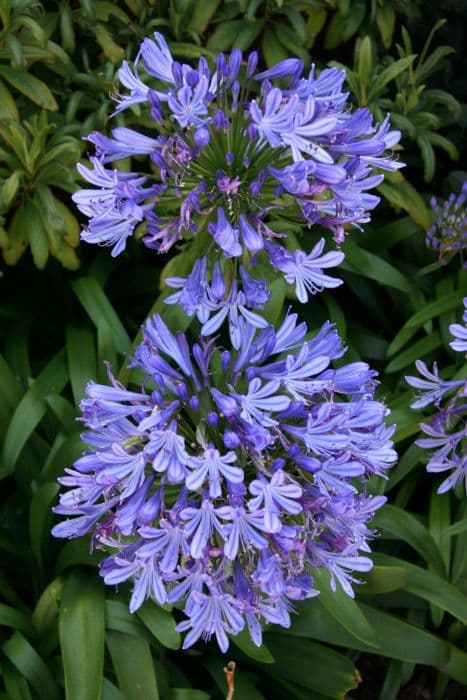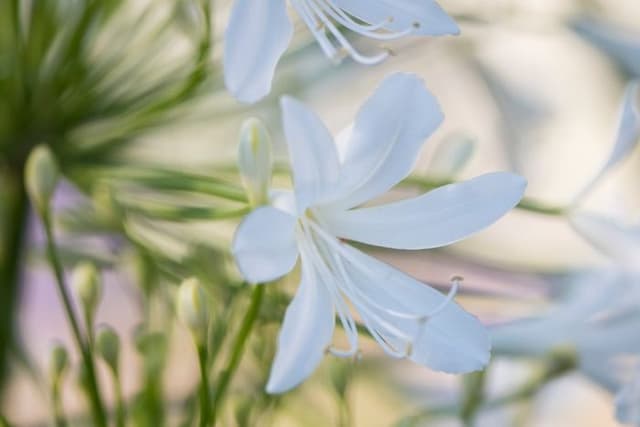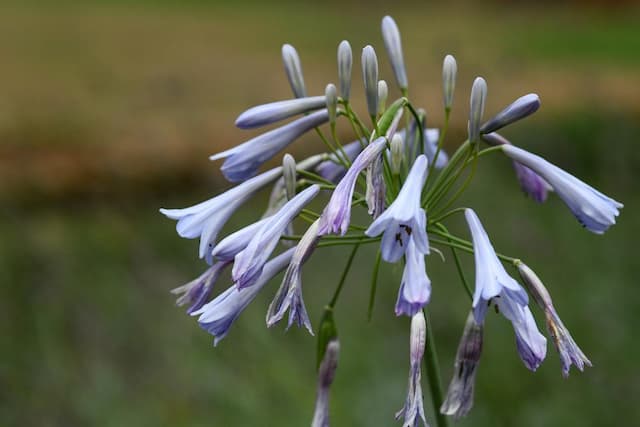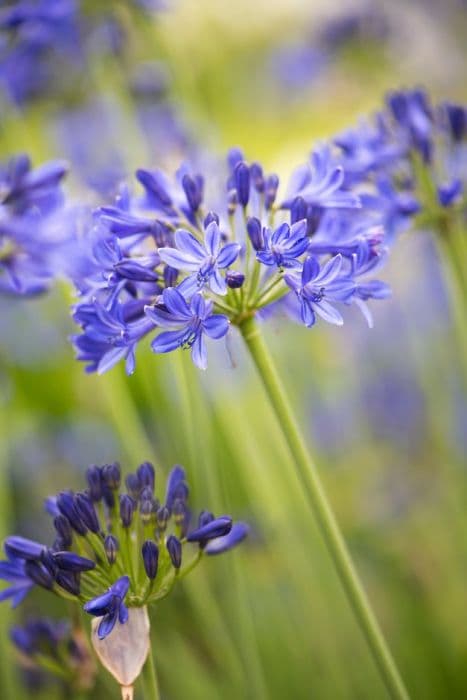Lily of the Nile Agapanthus 'Strawberry Ice'

ABOUT
Agapanthus 'Strawberry Ice' is a striking ornamental plant that features clumps of strappy, arching green leaves, creating a lush foundation from which tall stems rise, supporting an impressive display of flowers. The blooms of the 'Strawberry Ice' variety are particularly eye-catching, presenting in soft pastel shades. Each spherical flower cluster, commonly known as an umbel, is made up of numerous trumpet-shaped flowers that range in color from creamy-white to pale pink, often with a delicate, subtle stripe that can be a deeper shade of pink or even a hint of violet. This perennial typically flowers during the summer months, adding a burst of color to gardens and landscapes. The elongated, smooth stalks that bear the flower heads appear to be reaching upwards as if to show off the floral arrangement to the world. The contrast of the dark, verdant foliage with the soft, pastel hues of the blossoms makes Agapanthus 'Strawberry Ice' a favorite among gardeners for creating a focal point or adding a touch of elegance to a flowering border. Despite the lack of specific size mentions, it's important to note that this plant is appreciated for its generous bloom size and the overall density of its foliage, which together create an attractive visual presence in any suitable garden setting.
About this plant
 Names
NamesFamily
Amaryllidaceae
Synonyms
African Lily, Lily of the Nile, Love Flower
Common names
Agapanthus 'Strawberry Ice'
 Toxicity
ToxicityTo humans
The Lily of the Nile, sometimes known by its subspecies name 'Strawberry Ice', can be toxic to humans if ingested. The plant contains compounds that can cause symptoms such as nausea, vomiting, and diarrhea. In some cases, it may also cause dizziness or skin irritation upon contact. It is important to avoid ingesting any part of this plant to prevent these symptoms.
To pets
The Lily of the Nile is also toxic to pets, including dogs and cats. If a pet ingests any part of this plant, they may experience symptoms like vomiting, nausea, and diarrhea. In severe cases, it may lead to tremors or cardiac issues. It’s important for pet owners to prevent their animals from eating this plant to avoid potential poisoning.
 Characteristics
CharacteristicsLife cycle
Perennials
Foliage type
Evergreen
Color of leaves
Green
Flower color
Pink
Height
2 feet (60 cm)
Spread
2 feet (60 cm)
Plant type
Bulb
Hardiness zones
8
Native area
South Africa
Benefits
 General Benefits
General Benefits- Ornamental Appeal: The Agapanthus 'Strawberry Ice' features attractive bicolored flowers with unique strawberry-pink and white petals that add visual interest to any garden or landscape.
- Drought Tolerance: Once established, this plant is relatively drought-tolerant, making it suitable for regions with water restrictions or dry climates.
- Low Maintenance: It requires minimal care once settled into its environment, making it a convenient choice for busy gardeners.
- Long Blooming Period: With a blooming period that extends through the summer months, it ensures a long-lasting display of color in gardens.
- Attracts Pollinators: The flowers of Agapanthus 'Strawberry Ice' are attractive to bees, butterflies, and other beneficial pollinators, supporting local ecosystems.
- Versatility in Landscaping: Suitable for borders, beds, and container gardening, this plant can adapt to various landscaping designs.
- Resilience to Pests and Diseases: The plant shows good resistance to many common pests and diseases, ensuring a healthier and more robust garden.
- Perennial Growth: As a perennial, it will return each year, reducing the need for annual replanting and providing a long-term garden fixture.
 Medical Properties
Medical PropertiesThis plant is not used for medical purposes.
 Air-purifying Qualities
Air-purifying QualitiesThis plant is not specifically known for air purifying qualities.
 Other Uses
Other Uses- Photography Backdrop: The Agapanthus's tall stems and colorful blooms can serve as an attractive backdrop for outdoor portrait photography.
- Textile Dye: The flowers of the Lily of the Nile, if properly processed, could potentially be used to create natural dyes for coloring fabrics.
- Educational Tool: Biology teachers can use these plants to illustrate concepts such as plant reproduction, seed dispersal, and pollinator attraction strategies.
- Artistic Inspiration: The unique shape and color of Lily of the Nile flowers can inspire designs in jewelry, textiles, and other art forms.
- Culinary Garnish: The vibrant petals, once ensured they are free from harmful treatments, could be used to decorate salads and desserts.
- Theme Gardens: They can be used to create a 'cool-toned' color theme in a garden, providing a calming visual effect.
- Special Events: The blooms of the Lily of the Nile can be used in floral arrangements for weddings and other celebrations to add a touch of elegance.
- Craft Projects: Dried flowers can be incorporated into crafts such as homemade paper or potpourri.
- Summer Shade Provider: When planted in groups, they can provide light shade for smaller, more delicate plants in the garden.
- Feng Shui: Potted Agapanthus can be used in the practice of Feng Shui to introduce elements of wood and water, thought to bring balance and positive energy into a home.
Interesting Facts
 Feng Shui
Feng ShuiThe Agapanthus is not used in Feng Shui practice.
 Zodiac Sign Compitability
Zodiac Sign CompitabilityThe Agapanthus is not used in astrology practice.
 Plant Symbolism
Plant Symbolism- Love Letters: Agapanthus, also known as Lily of the Nile, often symbolizes love letters or messages due to its tubular shape, resembling rolled parchment or scrolls.
- Enduring Love: The sturdy and resilient nature of the plant represents enduring love that stands the test of time.
- Beauty: With its striking colors and beautiful flower clusters, Lily of the Nile is often associated with beauty and admiration.
- Fertility: In some cultures, the lush and prolific blooms of agapanthus are symbolic of fertility and abundance.
- Home: The plant's ability to thrive in varied conditions can symbolize a safe and happy home.
 Water
WaterThe Lily of the Nile, commonly known as Agapanthus 'Strawberry Ice,' should be watered deeply to ensure the water reaches the root zone, approximately every one to two weeks depending on the climate and soil moisture levels; during hotter months, you might need to water more frequently. You should provide enough water to soak the soil to a depth of at least an inch. An established plant typically requires about 1 gallon of water per session. It's advisable to reduce watering frequency during the winter when the plant is not actively growing. Be careful to avoid overwatering, as this can lead to root rot.
 Light
LightAgapanthus 'Strawberry Ice' thrives best in full sun to partial shade conditions. The ideal location for this Lily of the Nile is a spot where it can receive at least 6 hours of sunlight daily. However, in extremely hot climates, some afternoon shade can help protect the plant from excessive heat stress. Avoid deep shade as it can hinder flowering and result in leggy growth.
 Temperature
TemperatureThe Lily of the Nile prefers temperatures between 60 and 85 degrees Fahrenheit but can survive brief periods of cold down to about 25 degrees Fahrenheit. It is not frost-tolerant, so in regions where temperatures fall below freezing, it should be grown in containers and brought indoors or provided with protective mulch. The ideal temperature range encourages healthy growth and abundant flowering in this perennial.
 Pruning
PruningPrune your Lily of the Nile after flowering by deadheading the spent blooms to encourage additional blooms and maintain a tidy appearance. In late winter or early spring, cut back any damaged or old foliage to about 4 inches above the ground to make way for new growth. Pruning can be done annually, timing it with the end of the blooming cycle or with the seasonal transition to promote healthy and vigorous plants.
 Cleaning
CleaningAs needed
 Soil
SoilLily of the Nile (Agapanthus 'Strawberry Ice') thrives best in a well-draining soil mix that is rich in organic matter, with a pH range of 6.0 to 7.0. A soil mix of two-thirds loam and one-third perlite or sand would be ideal, as it provides the right balance of moisture retention and drainage. Adding compost or well-rotted manure will enrich the soil, benefiting the plant's growth and flowering.
 Repotting
RepottingLily of the Nile should be repotted every 3 to 4 years or when it becomes root-bound. It's best to repot in the spring before the growing season starts, and this will give the plant room to grow and ensure it keeps flowering. Since Agapanthus can thrive with their roots somewhat crowded, don't rush to repotting too frequently.
 Humidity & Misting
Humidity & MistingLily of the Nile prefers moderate humidity levels but is adaptable to different humidity conditions. It does not require high humidity, making it quite suitable for typical indoor environments. Aim for a humidity level around 40-50% for optimal growth.
 Suitable locations
Suitable locationsIndoor
Give Lily of the Nile bright light, and water when soil is dry.
Outdoor
Place Lily of the Nile in full sun to partial shade, in rich soil.
Hardiness zone
8-10 USDA
 Life cycle
Life cycleAgapanthus 'Strawberry Ice', commonly known as Lily of the Nile, begins its life cycle as a seed, which when sown, germinates to sprout roots and shoots. As the seedling grows, it develops into a vegetative plant with strap-like leaves and establishes a robust root system. Following its vegetative stage, the plant enters its reproductive phase typically in the summer, producing tall flower stalks called scapes, which bear clusters of trumpet-shaped, light pink flowers. After flowering, the plant sets seed, which can disperse and lead to the growth of new plants. Once the flowering season ends, the plant goes into a period of dormancy, especially in cooler climates, where the foliage may die back and the plant conserves energy in its rhizomes. With the return of favorable conditions in spring, the plant breaks dormancy, initiating a new growth cycle.
 Propogation
PropogationPropogation time
Early Spring
Propogation: The Agapanthus, commonly known as the African Lily 'Strawberry Ice', is best propagated in the spring or early summer through division. To propagate by division, carefully lift the plant from the ground using a spade, ensuring a good amount of root and shoots are included with each section. Gently pull apart the clumps of bulbs with your hands or cut them with a sharp knife if necessary. Each division should have at least one developing shoot and a portion of the root system. Replant the divisions at the same depth they were originally growing, spacing them about 18 inches (approximately 45 centimeters) apart to give them room to grow. Water the newly planted divisions thoroughly to establish them in their new location. Division is the most popular method of propagation for this plant because it maintains the characteristics of the parent plant and is a fairly quick method to obtain mature plants.









